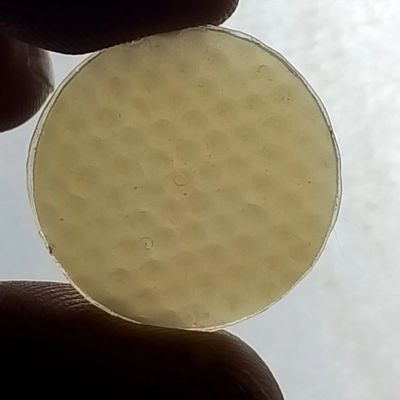Influence of composite Interfaces over Mechanical Keying

The Role Of Macro Mechanical Keys
This page explores the universal role of interfaces in resin composites, the impact of interfacial surface area on stress transfer, and how directional features, such as macro mechanical keys, influence the mechanical response of isotropic dental composite materials. By integrating concepts from fiber-reinforced systems into isotropic particulate-filled composites, we propose innovative strategies for optimizing composite material behavior under various loading conditions.
Introduction
Resin composites are pivotal in numerous engineering and medical applications due to their customizable mechanical properties. Key to their performance is the efficient transfer of stresses across the fiber-resin interface. This page delves into:
- The role of directionality of interfaces.
- The implications of increased interfacial surface area brought about by a macrotextured FEP film we call GLIMMER.
- The anisotropic effects introduced during incremental layering processes.
- The benefits of introducing macro-mechanical keying features using GLIMMER FEP release film.
Role of Interface Directionality in Stress Transfer
The orientation of the interface plays a crucial role in governing stress distribution and transfer within resin composites. Insufficient macro-mechanical bonding at the interface can significantly diminish the reinforcing effect, compromising the material's performance. This underscores the importance of optimizing interfacial keying to enhance the overall mechanical response, particularly for resin composites designed for highly aesthetic and demanding applications in both dentistry and the broader 3D printing industry.
Interface Alignment Within Composite
Properly layered and aligned interfaces, even in the absence of fibers, facilitate uniform stress distribution and mitigate stress concentrations .
Surface Preparation
Techniques like sandblasting improve interfacial bonding but may introduce defects that compromise efficient stress transfer and material integrity.
Influence of Increased Interfacial Surface Area
In resin composites, an increase in the interfacial surface area enhances the bond strength between fibers and resin. A very common method to achieve this is by using woven glass fiber mats.
This approach help distribute mechanical loads more evenly, but the fibers have to be most certainly embedded into each lamina or layer.
The Difference Netfil brings in
The Netfil concept is centered on distributing mechanical loads through macro-mechanically keyed interfaces, which are generated within composites during the layer-by-layer 3D printing process
The STANDARD 3D PRINTING APPROACH

In a standard FEP plain film used in 3D printing, effective stress transfer within the 3D-printed lamina is hindered due to the lack of macro mechanical keying. The smooth surface of plain FEP films prevents mechanical interlocking between layers, leading to weak interfaces and compromised structural integrity.
This absence of keying results in weak interlayer bonds, making the printed object remain isotropic, with significantly lower strength and stiffness in the interlayer direction. It increases the risk of delamination under tensile or shear loads and promotes brittle failure, as cracks propagate more easily along these weak planes.
To overcome these challenges, textured or patterned FEP films can introduce macro mechanical keying, creating anchoring points that improve interlayer bonding and stress transfer. This enhancement promotes better mechanical isotropy and improves the overall performance of the printed objects.
THE NETFIL 3D PRINTING APPROACH

In the Netfil 3D printing approach, the limitations of standard FEP plain films are addressed by incorporating macro mechanical keying through specialized textured surfaces or patterns on the film. This design enables effective stress transfer within the 3D-printed lamina by creating physical macro mechanical keys or interlocks between layers of cured resin.
The textured surface facilitates mechanical interlocking at the interface, significantly strengthening interlayer adhesion and facilitates the transfer of shear strains within the printed part.
Macro mechanical keying therefore allow stress to be distributed more evenly across the layers, reducing stress concentrations and increasing the durability of the printed object.
The macromechanical keying provided by the textured film minimizes the risk of delamination, even under tensile or shear loads.
By improving interlayer bonding, the Netfil approach reduces the isotropic behavior of the printed composite, achieving more strength and stiffness in a specific direction.
The stronger interlayer bonds and improved stress transfer make Netfil-printed objects better suited for high-performance and load-bearing applications.
the world's first macrotextured 3d printing fep film

Designed to Enhance the Stiffness of 3D Printed Parts
GLIMMER Macrotextured FEP Film—a game-changing innovation engineered to improve the stiffness and strength of 3D printed parts.
Key Benefits
Improved Part Stiffness
The macrotextured surface macro mechanically keys the printed layers , resulting in superior bonding and enhanced mechanical properties, including stiffness.
Efficient Stress Transfer
The macrotexture promotes effective stress distribution across the layers, reducing weak points and improving the overall durability of printed parts.
Customizable Texturing: Isotropic and Anisotropic Patterns
Currently, we offer the ability to texture the sheet using both isotropic and anisotropic patterns, including hexagonal and rhombic designs.
Custom Texturing for Any Thickness of FEP Film
Our innovative process allows us to apply isotropic or anisotropic textures—such as hexagons and rhombuses—to FEP films of any thickness.
Fast Shipping and Easy Returns
We offer fast shipping on all orders and easy returns. If you are not satisfied with your purchase, we will work with you to make it right. We are committed to providing the best customer service to our customers.
Copyright © 2025 DM101 - All Rights Reserved.
Powered by GoDaddy
This website uses cookies.
We use cookies to analyze website traffic and optimize your website experience. By accepting our use of cookies, your data will be aggregated with all other user data.